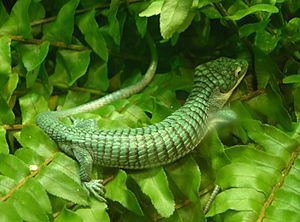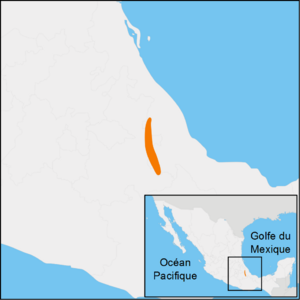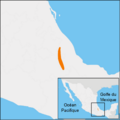Mexican alligator lizard facts for kids
Quick facts for kids Mexican alligator lizard |
|
|---|---|
 |
|
| Abronia graminea | |
| Conservation status | |
| Scientific classification | |
| Genus: |
Abronia (lizard)
|
| Species: |
graminea
|
The Mexican alligator lizard (Abronia graminea) is a cool reptile also called the green arboreal alligator lizard. It's an endangered lizard found only in the Sierra Madre de Oaxaca mountains of Mexico. You can find it in the states of Puebla, Veracruz, and Oaxaca. A scientist named Edward D. Cope first described it in 1864.
This lizard loves living in trees, which is called an arboreal lifestyle. It often hides in plants like bromeliads that grow on trees in cloud or pine-oak forests. These places are usually humid and warm, with rain in the summer. The Mexican alligator lizard mostly eats different kinds of insects. Adults can be bright emerald green or dark blue. Young lizards are tan with dark stripes across their bodies.
The IUCN (International Union for Conservation of Nature) says the Mexican alligator lizard is endangered. This is mainly because its home is being destroyed by fires, cutting down trees, and changing land for farming. People also illegally catch these lizards to sell as pets, which makes the problem worse.
Contents
About the Mexican Alligator Lizard
What's in a Name?
The group of lizards called Abronia was first named by John Edward Gray in 1838. Later, in 1864, Edward D. Cope described a new species he called Gerrhonotus gramineus. This name was used for many years.
In 1949, scientists decided to move this lizard to the Abronia group. For a while, some thought it was a subspecies of another lizard, A. taeniata. But in 1955, another scientist named Martin showed that A. graminea was different enough to be its own species. So, its official name today is Abronia graminea.
A. graminea is one of 29 species in the Abronia group. Scientists are still learning about how it's related to other Abronia lizards. It lives in some of the same areas as A. taeniata. You can tell them apart by looking at their scales and colors. A. graminea has fewer rows of scales on its back and neck. Also, adult A. graminea are usually one solid color, while A. taeniata adults have dark stripes.
Different Names for the Lizard
| Language | Name |
|---|---|
| English | Mexican alligator lizard
Green arboreal alligator lizard Terrestrial arboreal alligator lizard |
| Spanish | Escorpión arboricola de Tehuacá
Dragoncito del Sur de la Sierra Madre Oriental Lagarto alicante terrestre |
How to Describe This Lizard
The Mexican alligator lizard has a body that is a bit flat from top to bottom. Its head is flat and shaped like a triangle. It can grow to about 10.6 centimeters (4 inches) long from its snout to the base of its tail. Its tail can be even longer, up to 16.0 centimeters (6 inches). One lizard that was 9.8 cm long weighed about 21.2 grams (0.75 ounces).
This lizard has a prehensile tail, which means it can use its tail to grab onto branches, just like a monkey! If it loses its tail, it can grow a new one. It also has long, strong legs and toes that help it climb and live in trees.
The colors of adult lizards are very different from young ones. Adult males are usually bright emerald green. Females can be bright to dull orange on their backs. Adults also have bright yellow skin around their eyes, blue hints on their upper lips, and a yellow snout, lower jaw, and throat. Young lizards are usually light tan with 9 black stripes on their body and 19 on their tail. Their belly is a dull yellow.
Here are some typical scale patterns for A. graminea:
- 12 rows of scales on its belly
- 25-29 rows of scales across its back
- 4-6 rows of scales on its neck
- 12-14 rows of scales along its back
- 11 scales on its upper lip
- 2 rows of scales on its lower lip (5 in the first row, 6 in the second)
The scales in front of its ears are bumpy. The scales on its back are slightly keeled, meaning they have a small ridge. The plates on its head are often thick and rough, making its head look triangular. Usually, the scales on its back are bigger than the ones on its belly.
Where the Lizard Lives
The Mexican alligator lizard lives only in the highlands of Mexico, along the Sierra Madre de Oaxaca mountain range. It lives in an area of about 11,500 square kilometers (4,440 square miles). This area includes the states of Puebla, Veracruz, and Oaxaca. These lizards are found at high elevations, from 1,350 to 2,743 meters (4,429 to 8,999 feet) above sea level.
Lizard Life and Habits
Habitat
The Mexican alligator lizard lives in humid, mountain forests. It is usually found in cloud forests or pine–oak forests. These places have a humid, mild climate, but the temperature can change a lot between day and night. Since it's an arboreal species, it lives among plants that grow on trees, especially bromeliads, but also lichens and orchids. These lizards can be found as high as 40 meters (130 feet) up in the forest canopy. A. graminea cannot live well in places where its habitat has been damaged.
Diet
When kept in captivity, A. graminea eats many different kinds of insects and other small creatures like spiders. Scientists don't know much about how they hunt for food in the wild.
Lifespan
No one knows exactly how long these lizards live in the wild. But in captivity, some A. graminea have lived for up to 10 years.
Reproduction and Life Cycle
A. graminea is a viviparous species, which means the females give birth to live babies instead of laying eggs. Females usually become old enough to have babies when they are about 3 years old. They can have litters of 1 to 12 babies at a time.
While scientists haven't seen them mate in the wild, mating usually happens in the summer or fall. The babies are then born in the spring. The mother carries the babies inside her for about 6 to 8 months before they are born.
Protecting the Mexican Alligator Lizard
Status
The Mexican alligator lizard is listed as an Endangered species on the IUCN Red List. This means it is at a very high risk of becoming extinct in the wild. It is also a protected animal under Mexican Federal Law, listed as a Threatened species on the Norma Oficial Mexicana list.
Threats
The biggest problems for this lizard are its habitat being broken up and destroyed. Forest fires, cutting down trees (deforestation), and changing land to use for farming have greatly damaged its home. This has also made the areas where A. graminea can live much smaller.
Another big threat is the illegal international trade. People catch A. graminea to sell them as pets, which has also contributed a lot to their endangered status.
Images for kids




